UXtra Show - Release 1: Dream Interfaces
Recently, a new show from the creators of Metrics - UXtra - has appeared in iTunes. UXtra is an English-language podcast about user experiences and interfaces, service design and business, created with the participation of the UIDG company and the usability alliance of companies UXalliance (the world leader in user experience and interface research). Especially for Habr's audience, the creators of the podcast prepared his transcript in Russian.
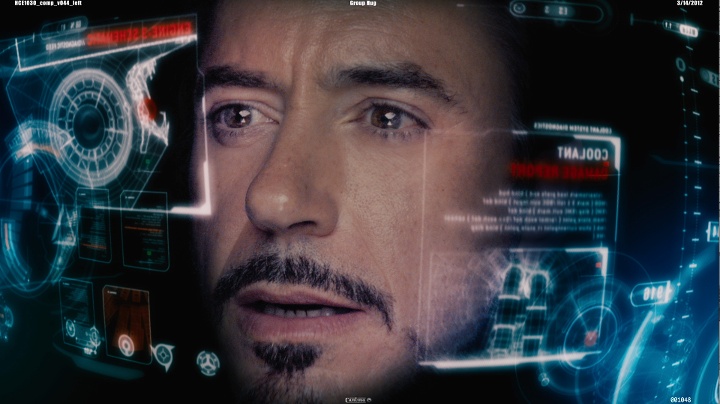
Author's note: We decided to remove the introductory words, ad inserts and slightly edited the text of the original for better susceptibility in Russian.
')
In the first episode I would like to greet all those who are not indifferent to the topics UI and UX. I will be happy to hear your comments, suggestions and feedback on the show. So, after we finished with the introductory part, you can proceed to the main topic of today's release. Preparing for the show, I thought about what thoughts everyone attends who embarks on a new project - you decide how it will evolve, you try to look into the future and understand what this or that aspect of your work will result in; you are wondering new goals. In my opinion, it is very important not to lose the overall picture of what is happening, a picture that extends far into the future and allows you to combine your knowledge and experience of colleagues and predecessors in order to set the correct project goals, clear and achievable.
Therefore, in this edition of the show, I decided to talk about futuristic interfaces (FUI, Futuristic User Interface). I mean those interfaces that we see in the cinema, which we read about and which we invent. I am convinced that, despite the not unreasonable talk about the practical applicability of futuristic interfaces, they inspire us, if we consider the question not from the point of view of a specific story or its characters, but from the point of view of elements supporting the plot, defining its kind of technological appeal and endearing our imagination is the imagination of today's users.
No, I will not make a selection of all however relevant to the topic of materials in the spirit of Wikipedia. On the contrary, I will ask introductory topics in order to arouse your interest in this issue and draw some necessary conclusions. I'm going to share my own, perhaps amateurish opinion and a look at the industry of futuristic interfaces. I call it an industry, since a huge number of user interface options were created not only during the development of information technologies, but also during the development of film production. An indirect confirmation of this can be the fact that, trying to find information about futuristic interfaces on the Internet, you will most likely first come across a ton of video clips, screenshots and UI mockups from various blockbusters.
One of such collections is Access Main Computer File - a blog with endless scrolling of screenshots from the films “Alien” (1979), “Luna 2112” (2009), “I, Robot” (2004), “Minority Report” (2002) and Series films about Iron Man. The creators of the blog talk about their compilation as a study of computer user interfaces in cinema.
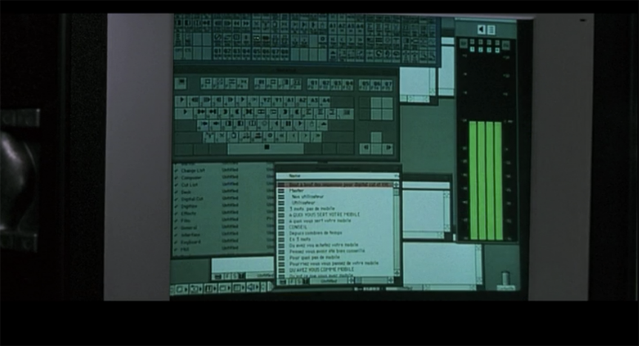
Ronin (1998)
A similar collection of images is also available on the Barnorama blog.
However, it is interesting to follow the steps of the evolution of futuristic interfaces, and the website Noteloop can help in this, the creators of which have collected, in my opinion, one of the best libraries of what can be called fantastic / fictional / non-existent interfaces from popular films and TV shows. Most of them are not real programs, but animation that plays on the screens at the right moment of shooting or added later during editing. As a rule, such animation is created in Adobe Illustrator, Adobe After Effects and Maxon Cinema 4D. So Noteloop Kit FUI is a database of such interfaces, like IMDb. However, the guys who made it included not only popular films and TV shows, but also advertising, video concepts, short films, as well as information about the designers who invented it all.

Continuum (TV series 2012)
Such blogs can help track the history of the development of futuristic interfaces, refresh memories of a particular concept, or even decide on the nearest movie for an evening viewing. They are good for exploring the topic, although the creators of such resources prefer not to delve into a detailed analysis of an interface. But what attracts people in futuristic interfaces, what makes people invent them? What allows them to overcome all the difficulties and with an enviable speed to create all new interfaces for a growing number of high-tech blockbusters?
In the magazine Pushing Pixels, I found an interesting interview with Jayse Hansen, who discusses the work of the graphics creator for screens and user interfaces in the movie. The article dates back to the first of June 2012, but it has not lost its relevance even now - from the designer who invented the interface for the Iron Man's helmet, you can learn a lot of interesting things. I like such articles, because they make it possible to understand what drives a person and how Jace, whose imagination struck scenes from Star Wars and Back to the Future in childhood, eventually became an expert in such large-scale projects as Iron Man.
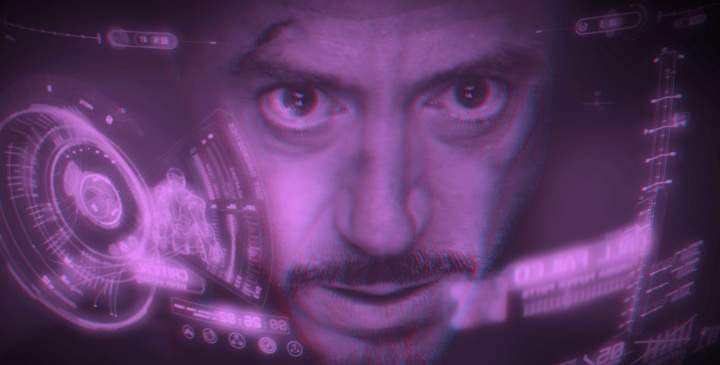
Iron Man 2 (2010)
The interview allows you to further explore the process of creating FUI - after all, Jace was involved in working on many interfaces for high-tech blockbuster heroes, starting with ideas and sketches and ending with stunning graphics. He should be trusted, if only because there are relatively few specialists of this kind and level in cinema. It is he who conducts basic research before starting work, which is based on a general description of a picture or part of a script. In particular, the work on the painting “Rise of the Planet of the Apes” required Jace to create a PDF portfolio for about 20 different script points. So in the profession of the creator of futuristic interfaces there is time for serious paper work.
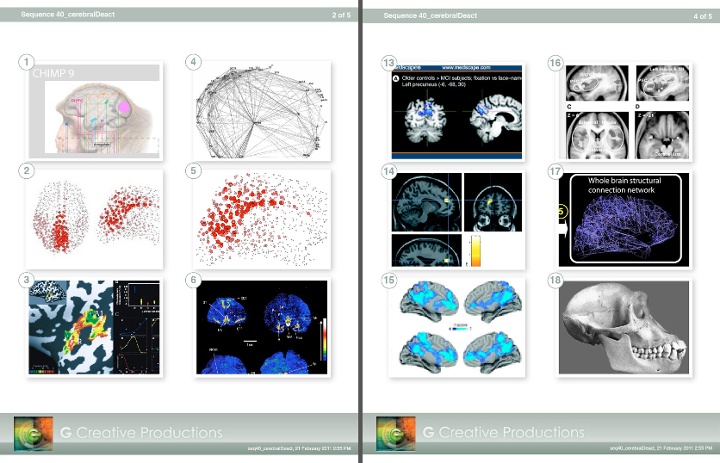
Materials for the preparation of the Rise of the Planet of the Apes (2011)
However, the development of futuristic interfaces are closely involved not only in the film industry, but also in the largest IT companies. Such concepts include Apple iLens , EEG brainwaves , Microsoft’s Productivity Future Vision vision , Cisco’s future shopping and mobile apps for oldies - TAT Open Innovation experiment , OmniTouch , Samsung Flexible AMOLED , BlackBerry Empathy , Mozilla Seabird Mobile Phone , as well as several recent (July 2013) Interactive Air Screen demo:
Returning to the films: there is one picture among high-tech blockbusters, which one cannot but mention in a conversation about futuristic interfaces. This, of course, "Minority Report." I found a nice article about her by Christian Brown (Christian Brown) on February 25, 2013, where the author criticizes the user interface from the film.
The film “Minority Report” was released in 2002, when touchscreen technology already existed, but the main task was to create practical, user-friendly products for this technology. In his article, Christian tells readers about a whole galaxy of technical experts and futurists who were developing the world of 2054 for the Spielberg film, based on what was a new breakthrough technology in 2002. So what? Was this knowledge used in designing UI? Most likely not, as Christian calls many of the interfaces ridiculous. He talks about those moments when, for example, in order to enlarge an object, you need to place one hand in front of the other or about a situation when, when shaking hands, all files fall into a corner. Christian calls it absurd.
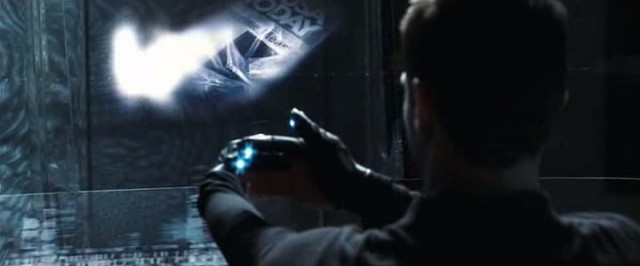
“Minority Report” (2002)
The idea of changing the position of a three-dimensional object by pushing it with one hand and turning the other seems to be even more unnatural - Christian points to Microsoft’s Productivity Future Vision vision as a much more logical example of working with objects in space, and hopes that one day, when filmmakers stop confusing computer work and conducting with an orchestra.
The next article on the topic is material from Smashing Magazine dated March 1, 2013. Its author, Christopher Noessel (Christopher Noessel) analyzed the "Dissent Interface" and made two important conclusions that are worth mentioning:
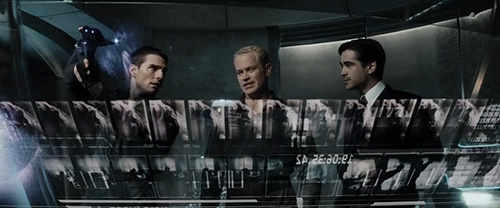

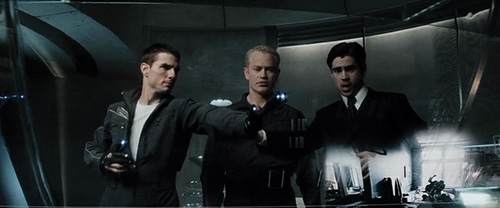
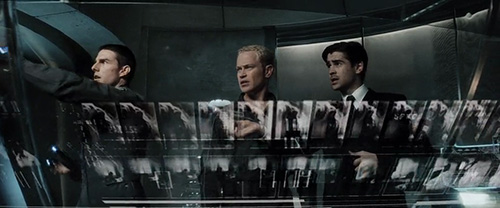
4 fragments from the film "Special Opinion" (2002)
This point forces Christopher to point out that such a system should definitely provide for various modes of operation: the mode when user actions are significant for the system and when they are insignificant.
In addition, Christopher chose the seven most widely used gestures used in various futuristic movie interfaces.
Christopher stresses that this list is incomplete, which presents great prospects for further analysis of other examples. And notes that one of the most important things here is the following: “Interfaces that use gestures are attractive and allow you to quickly interact with virtual objects in a“ real ”format, but outside the basic examples of manipulating objects with gestures are complex, inefficient and difficult to remember. For more abstract requests, designers should offer alternative ways to interact, such as voice input. ”
That's all. In addition to all the materials mentioned above, I will add a link to the latest works by Joseph Kosinski and Crater Lake Productions for Oblivion, an interview with Shaun Yue, who participated in the creation of interfaces for Prometheus and “007: The coordinates of Skyfall, and even more interfaces from Iron Man.

Author's note: We decided to remove the introductory words, ad inserts and slightly edited the text of the original for better susceptibility in Russian.
')
In the first episode I would like to greet all those who are not indifferent to the topics UI and UX. I will be happy to hear your comments, suggestions and feedback on the show. So, after we finished with the introductory part, you can proceed to the main topic of today's release. Preparing for the show, I thought about what thoughts everyone attends who embarks on a new project - you decide how it will evolve, you try to look into the future and understand what this or that aspect of your work will result in; you are wondering new goals. In my opinion, it is very important not to lose the overall picture of what is happening, a picture that extends far into the future and allows you to combine your knowledge and experience of colleagues and predecessors in order to set the correct project goals, clear and achievable.
Therefore, in this edition of the show, I decided to talk about futuristic interfaces (FUI, Futuristic User Interface). I mean those interfaces that we see in the cinema, which we read about and which we invent. I am convinced that, despite the not unreasonable talk about the practical applicability of futuristic interfaces, they inspire us, if we consider the question not from the point of view of a specific story or its characters, but from the point of view of elements supporting the plot, defining its kind of technological appeal and endearing our imagination is the imagination of today's users.
No, I will not make a selection of all however relevant to the topic of materials in the spirit of Wikipedia. On the contrary, I will ask introductory topics in order to arouse your interest in this issue and draw some necessary conclusions. I'm going to share my own, perhaps amateurish opinion and a look at the industry of futuristic interfaces. I call it an industry, since a huge number of user interface options were created not only during the development of information technologies, but also during the development of film production. An indirect confirmation of this can be the fact that, trying to find information about futuristic interfaces on the Internet, you will most likely first come across a ton of video clips, screenshots and UI mockups from various blockbusters.
One of such collections is Access Main Computer File - a blog with endless scrolling of screenshots from the films “Alien” (1979), “Luna 2112” (2009), “I, Robot” (2004), “Minority Report” (2002) and Series films about Iron Man. The creators of the blog talk about their compilation as a study of computer user interfaces in cinema.

Ronin (1998)
A similar collection of images is also available on the Barnorama blog.
However, it is interesting to follow the steps of the evolution of futuristic interfaces, and the website Noteloop can help in this, the creators of which have collected, in my opinion, one of the best libraries of what can be called fantastic / fictional / non-existent interfaces from popular films and TV shows. Most of them are not real programs, but animation that plays on the screens at the right moment of shooting or added later during editing. As a rule, such animation is created in Adobe Illustrator, Adobe After Effects and Maxon Cinema 4D. So Noteloop Kit FUI is a database of such interfaces, like IMDb. However, the guys who made it included not only popular films and TV shows, but also advertising, video concepts, short films, as well as information about the designers who invented it all.

Continuum (TV series 2012)
Such blogs can help track the history of the development of futuristic interfaces, refresh memories of a particular concept, or even decide on the nearest movie for an evening viewing. They are good for exploring the topic, although the creators of such resources prefer not to delve into a detailed analysis of an interface. But what attracts people in futuristic interfaces, what makes people invent them? What allows them to overcome all the difficulties and with an enviable speed to create all new interfaces for a growing number of high-tech blockbusters?
In the magazine Pushing Pixels, I found an interesting interview with Jayse Hansen, who discusses the work of the graphics creator for screens and user interfaces in the movie. The article dates back to the first of June 2012, but it has not lost its relevance even now - from the designer who invented the interface for the Iron Man's helmet, you can learn a lot of interesting things. I like such articles, because they make it possible to understand what drives a person and how Jace, whose imagination struck scenes from Star Wars and Back to the Future in childhood, eventually became an expert in such large-scale projects as Iron Man.

Iron Man 2 (2010)
The interview allows you to further explore the process of creating FUI - after all, Jace was involved in working on many interfaces for high-tech blockbuster heroes, starting with ideas and sketches and ending with stunning graphics. He should be trusted, if only because there are relatively few specialists of this kind and level in cinema. It is he who conducts basic research before starting work, which is based on a general description of a picture or part of a script. In particular, the work on the painting “Rise of the Planet of the Apes” required Jace to create a PDF portfolio for about 20 different script points. So in the profession of the creator of futuristic interfaces there is time for serious paper work.

Materials for the preparation of the Rise of the Planet of the Apes (2011)
However, the development of futuristic interfaces are closely involved not only in the film industry, but also in the largest IT companies. Such concepts include Apple iLens , EEG brainwaves , Microsoft’s Productivity Future Vision vision , Cisco’s future shopping and mobile apps for oldies - TAT Open Innovation experiment , OmniTouch , Samsung Flexible AMOLED , BlackBerry Empathy , Mozilla Seabird Mobile Phone , as well as several recent (July 2013) Interactive Air Screen demo:
Returning to the films: there is one picture among high-tech blockbusters, which one cannot but mention in a conversation about futuristic interfaces. This, of course, "Minority Report." I found a nice article about her by Christian Brown (Christian Brown) on February 25, 2013, where the author criticizes the user interface from the film.
The film “Minority Report” was released in 2002, when touchscreen technology already existed, but the main task was to create practical, user-friendly products for this technology. In his article, Christian tells readers about a whole galaxy of technical experts and futurists who were developing the world of 2054 for the Spielberg film, based on what was a new breakthrough technology in 2002. So what? Was this knowledge used in designing UI? Most likely not, as Christian calls many of the interfaces ridiculous. He talks about those moments when, for example, in order to enlarge an object, you need to place one hand in front of the other or about a situation when, when shaking hands, all files fall into a corner. Christian calls it absurd.

“Minority Report” (2002)
The idea of changing the position of a three-dimensional object by pushing it with one hand and turning the other seems to be even more unnatural - Christian points to Microsoft’s Productivity Future Vision vision as a much more logical example of working with objects in space, and hopes that one day, when filmmakers stop confusing computer work and conducting with an orchestra.
The next article on the topic is material from Smashing Magazine dated March 1, 2013. Its author, Christopher Noessel (Christopher Noessel) analyzed the "Dissent Interface" and made two important conclusions that are worth mentioning:
- Conclusion 1. A quality demonstration can hide many flaws. Of course, everyone knows that Tom Cruise needed long breaks between filming scenes with a computer interface, because they were physically exhausting. Such interruptions turned out to be extremely useful, although they did not reflect the real state of things - which shows how an ineffective solution can be successfully demonstrated by omitting some details.
- Conclusion 2. An interface that uses gestures should consider the user's goals. Again, this is the moment when Anderton breaks away from work to shake hands with Whitver. The computer perceives Anderton's gesture as a command, and nearly destroys all his work.




4 fragments from the film "Special Opinion" (2002)
This point forces Christopher to point out that such a system should definitely provide for various modes of operation: the mode when user actions are significant for the system and when they are insignificant.
In addition, Christopher chose the seven most widely used gestures used in various futuristic movie interfaces.
- Hold your hand to activate. In the film “The Day When Earth Has Stopped”, in order to activate the interface of the spacecraft, you just had to hold your hand in front of the translucent activation panel, and in “Johnny Mnemonica”, you had to hold the water in the bathroom to open water.

"Johnny Mnemonic" (1995) - Push to slide. We saw this in the “Dissenting Opinion” and again noticed in “Iron Man 2”, for example, in the moment where Tony moves the projection of his father's theme park.
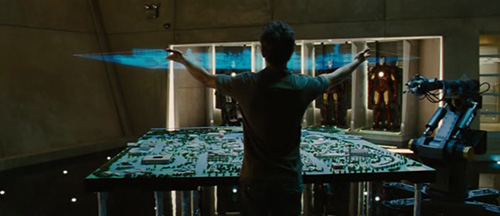
Iron Man 2 (2010) - Turn to turn. We saw this in the episode "Ariel" from the TV series "Firefly" in 2002.
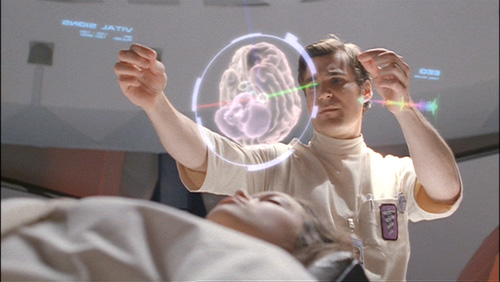
"Firefly" (TV series 2002) - Swipe to cancel. In “Johnny Mnemonic”, vigorously waving the back of his hand upwards, the video call could be canceled, and in “Iron Man 2”, by “swiping from right to left” movement, Tony sifted out uninteresting images.

"Johnny Mnemonic" (1995) - Point or touch to select. In District 9, Christopher Johnson chose elements on a three-dimensional display, touching them.
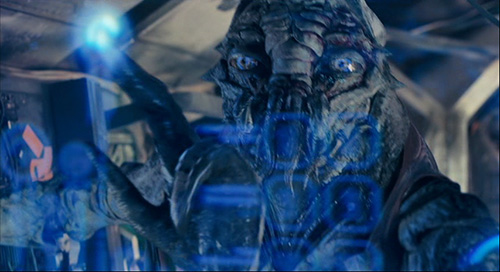
"District number 9" (2009) - Open your palm to shoot. This is how the energy beam from the palms of the Syndrome from the "Supercamera" and similar energy beams from the "Iron Man" palms appeared.
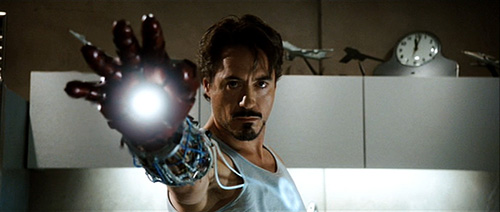
Iron Man 2 (2010) - Squeeze or spread your fingers to scale. Both Tony Stark uses both of them, considering the models in the second “Iron Man”.
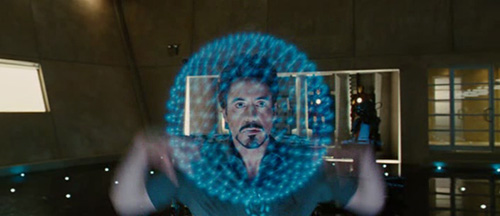
Iron Man 2 (2010)
Christopher stresses that this list is incomplete, which presents great prospects for further analysis of other examples. And notes that one of the most important things here is the following: “Interfaces that use gestures are attractive and allow you to quickly interact with virtual objects in a“ real ”format, but outside the basic examples of manipulating objects with gestures are complex, inefficient and difficult to remember. For more abstract requests, designers should offer alternative ways to interact, such as voice input. ”
That's all. In addition to all the materials mentioned above, I will add a link to the latest works by Joseph Kosinski and Crater Lake Productions for Oblivion, an interview with Shaun Yue, who participated in the creation of interfaces for Prometheus and “007: The coordinates of Skyfall, and even more interfaces from Iron Man.
Source: https://habr.com/ru/post/188208/
All Articles